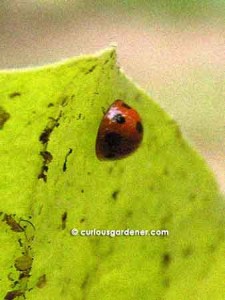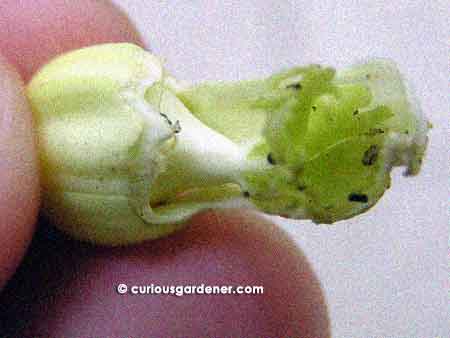
Tight cluster of black aphids nursed by ants.
I’m beginning to get a sense of dread whenever I see excited ants clustered on my plants. First it was the black ants all agog over the mealy bug infestation on my fastest-growing Red Lady papaya tree. Yes, I know the insects secrete a kind of nectar that the ants enjoy, but I sure didn’t reciprocate the enjoyment at all. The infestation was so bad that I got rid of the plant just to get rid of the mealy bugs.
So, when I saw large orange ants (thankfully not kerenga fire ants) in a cluster along the stem of one of my long bean plants last week, my pulse rate faltered then sped up. What now? They were way more excited than they normally are when the plants begin to flower.

Up close and personal with black aphids. They're that fat because they've fed off sap from the plant stem. :(
Closer inspection revealed something black that had a very lumpy surface. I did not like that one bit. It turned out to be a colony of black aphids that seemed to like the home provided by the rough strands of the twine that the long bean stem was wound around, and that their food – the stem – was so close at hand. My protective streak overrode all else, and I got the insecticide and sprayed, carefully, the twine, so that it soaked up the liquid to make it less attractive to the aphids. The ants dispersed hurriedly once they got the scent, but the aphids just stayed there. Mindful that the plant does need other insects to come by to pollinate the flowers, I didn’t spray a lot, just hoping that the dose I’d given would make them lose interest, or at least die a slow, painful death. 
Early the following day, I found that there were still some aphids left, so I mentally braced myself and removed the soft, squishy insects by hand. I did not enjoy that experience at all.

Little ladybug on the underside of a brinjal leaf
A few days later, there were a couple more clusters on the next vine. Again, I sprayed the twine.
Note to self: better stop using twine if it attracts aphids!
Again, the following day, I removed the remaining aphids by hand. While I was doing that, something caught my eye. I have a few potted brinjal plants growing just in front of the trellis. There, on the edge of the underside of one of the leaves, was a bright red dot … a ladybug!
This is the first time that the principle of beneficial insects coming to the garden because the pests (their food) are there has happened to me! At least, I assume it was there because of the aphids. I’ve been adding other flowering plants in the vicinity as an invitation to beneficial insects, but they’re not in full bloom yet. It had to be the aphids that brought it there, right?
I immediately put the insecticide aside. Hopefully, it won’t chase off the ladybug, or worse, harm it. Of course, this means I have to be hands-off where the aphids are concerned, and leave their management to the ladybug(s). If the ladybug was there because of the aphids then I can say I’ve never been so happy to have aphids around!
© 2011 curiousgardener.com All rights reserved.







